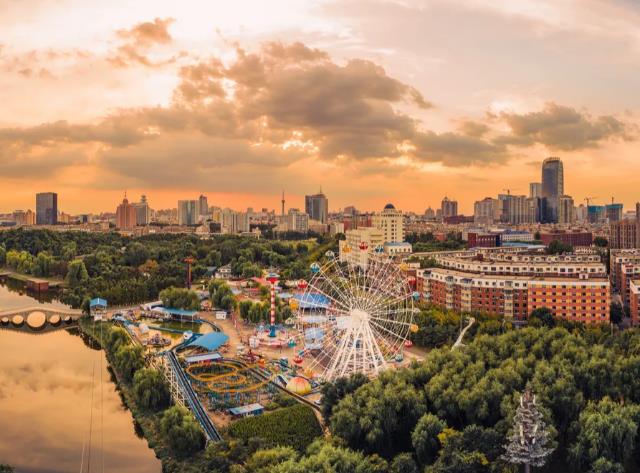https://ph.trip.com/moments/poi-huayan-temple-18216969
3.3
4.6/5
16 review
Historic buildings
The original name of Huayan Temple in Laoshan is "Huayan Temple", also known as "Huayan Temple". It is surrounded by mountains on three sides and the sea in the east. It is simple and elegant and majestic. Huayan Temple is a large-scale Buddhist temple in Laoshan, covering an area of 4,000 square meters, with a construction area of 2,000 square meters and more than 120 houses. It is a four-entry courtyard. The current Huayan Temple was renovated in 1999. It is a wooden building with double eaves and bucket arches. The entire hall is gorgeous and noble, reflecting the style of Buddhism and the characteristics of the "Lotus Tibetan World", that is, the Huayan Daqian World.
Address:
Laoshan Scenic Area, Laoshan District, QingdaoRecommended sightseeing time:
0.5-1 hourPhone:
0532-96616,0532-87979249Ticket Price
Free entryQingdao Laoshan Mountain Super Simple Guide | One-Day Tour of the Mountain and Sea Wonderland
【🌊Highlights】
✅ The world's highest peak on a coastline | One of the birthplaces of Taoism
✅ Spectacular mountain and sea scenery | In-depth experience of a 5A-level scenic spot
✅ Four famous scenic spots condensed | Dual heritage of humanity + nature
🚗【Efficient Routes】
① Yangkou Line (Classic): Mountain and Sea Highway + Taiqing Palace + Mingxia Cave (3h)
② Taiqing Line (Cultural): Thousand-year-old temple + Laoshan tea garden (2h)
③ Bashuihe Line (Niche): Popular lighthouse + panoramic view of the fishing village (1.5h hike)
⛰️【Must-See Spots】
• Laoshan Peak, Mitian Cave: Climb to the top to watch the sunrise over the Yellow Sea
• Taiqing Bay: "The Best Beach Under Heaven" with blue sea and golden sand
• Huayan Temple: Thousand-year-old ginkgo + thousand-year-old cypress
• Mingxia Cave: A natural cave and Taoist sanctuary
🍲【Foodie Delights】
✔️ Laoshan mushroom stewed chicken (mountain delicacy)
✔️ Seaweed jelly (local specialty snack)
✔️ Fisherman's mixed fish pot stickers (freshly made)
🏡【Accommodation Recommendations】
▫️ Yangkou fisherman's homestay (wake up to ocean views)
▫️ Taiqing Scenic Area teahouse (mountain tranquility)
💡【Tips to Avoid Pitfalls】
⚠️ Hike before 7:30 am or after 5:30 pm to avoid crowds
⚠️ Book Taiqing Palace tickets online in advance
⚠️ Bring a jacket due to large temperature differences on the mountain
⚠️ Take the cable car down the mountain to save energy
📌【Pre-Trip Tips】
✔️ Pack light for hiking + non-slip shoes are essential
✔️ The best time to buy Laoshan tea is before Qingming Festival
✔️ Check the weather forecast and choose a sunny day
✨In short: Experience the Taoist philosophy of harmony between man and nature in a 20-billion-year-old geological wonder, and enjoy the visual feast of the mountain meeting the sea!
Liam Wilson Liam^4
Climbing High and Gazing Far: A Day Trip Guide to Laoshan Yangkou Scenic Area in Qingdao
⛰️A paradise on earth, Laoshan on the sea! No need to travel far, drive to the Laoshan Yangkou Scenic Area, climb high and gaze far between the mountains and the sea, and experience the beautiful scenery of Laoshan! Here's a self-drive day trip guide!
🗓Laoshan Yangkou One-Day Itinerary
Departure from Qingdao urban area➡️Laoshan Yangkou Scenic Area➡️Qingshan Fishing Village➡️Huayan Temple➡️Return
💎Attractions
✅Laoshan Yangkou Scenic Area
🎫90 CNY/person, including tickets for Taiqing, Yangkou, and Huayan scenic areas + sightseeing bus
📍Detailed address: Wanggezhuang Subdistrict, Laoshan District, Qingdao
🚗Transportation guide: Navigate to Laoshan Yangkou Scenic Area by car; free parking is available.
🕙Opening hours: 07:30–16:30
🧵Tour route: Hiking throughout
Ticket gate→Cable car lower station→Taiping Palace→Shouzi Peak→Mitian Cave Palace→Tian Yuan→Return via the same route!
You can choose a full or half-way cable car ride based on your physical condition. Cable car tickets are charged separately.
Yangkou Scenic Area is located in the northeast of Laoshan Mountain. The peaks within the scenic area stand tall and imposing, including Lion Peak, which resembles a male lion, Sheep Stone, shaped like a sheep, and Peach Stone, resembling a fairy peach. There's also Shouzi Peak, engraved with numerous large and small "Shou" (longevity) characters, and various caves such as White Dragon Cave, Youlong Cave, and Mitian Cave. There's also Taiping Palace, a Taoist holy site built in the Song Dynasty!
At Tian Yuan on the mountaintop, you can overlook the natural scenery of Yangkou Bay, where the fresh air will refresh your mind and body!
✅Qingshan Fishing Village
🎫Free!
Qingshan Fishing Village, a popular spot for online influencers! A paradise with over 600 years of history, terraced tea gardens, and layers of red-tiled houses built along the sea and mountains. Fishing boats moored at the wharf, and the rippling blue waves of Qingshan Bay make it feel like a "fairyland between mountains and seas"!
📷Photo spots
The entire mountain and sea road along the way, the large archway of Qingshan Fishing Village, Yako, Qingshan South, Huangshan Village, Diaolongzui Village, and Huayan Temple are all great places for taking photos!
✅Huayan Temple
📍Detailed address: West Narayana Mountain, Fanlinghou Village, Wanggezhuang Town, Laoshan District, Qingdao
🕙Opening hours: 07:00–17:30
Surrounded by mountains on three sides, the scenery here is lush and green, and the walk is easy and not tiring!
Huayan Temple is a large Buddhist temple in Laoshan. In autumn, the ginkgo trees at Huayan Temple are famous far and wide, attracting many citizens and photography enthusiasts to take photos. The ginkgo leaves are golden and brilliant, and the maple leaves are fiery red and dazzling!
📝Tips:
[One] The weather is cold in winter, so dress warmly!
[Two] Wear hiking boots and bring a thermos with hot water!
[Three] There are farmhouse meals available, with prices to suit all budgets!
D@v.d M00r3
Huayan Temple is a hidden gem known only to locals.
Tired of the crowds at the big attractions? Visit Huayan Temple, a hidden gem known only to locals, and enjoy a relaxing weekend.
Search for "P Huayan Temple Parking Lot" to find the location.
The parking lot is right next to the scenic area, less than 100 meters away, making it super convenient.
Make sure to book a special farmhouse meal or homestay in advance to ensure smooth entry and exit at the Yangkou Checkpoint.
About Huayan Temple
Huayan Temple, originally known as Huayan Nunnery, is the only Buddhist temple in the Laoshan Scenic Area. It is located halfway up the Naloyan Mountain, a branch of Laoshan Mountain, surrounded by mountains on three sides and the sea on the left. In 1982, Huayan Temple was listed as a key cultural relic protection unit in Qingdao. Must-see attractions:
Naloyan Cave: A tall cave said to be the place where the Naloyan God became a Buddha. Its grandeur is breathtaking.
There is a thousand-year-old ginkgo tree at the main entrance of Huayan Temple, which is a great photo spot in mid-November.
Tour time:
The tour is relatively simple. It takes about 2.5 hours to go from the Huazang World Gate to Huayan Temple and then to Naloyan Cave.
OskarRasmussen
Qingdao Huayan Temple | A place of tranquility for the soul.
| A place of tranquility for the soul.
Hey guys👫, today I have to share with you Huayan Temple in Qingdao, a magical place that can cleanse your soul😌.
Huayan Temple is located on the southwest slope of the Naluoyan Mountain on the east coast of Laoshan. It is surrounded by mountains on three sides and the sea to the east. It is the only existing Buddhist temple in Laoshan. When you step into this sacred place, it feels like you are instantly away from the hustle and bustle of the world and enter a peaceful and harmonious world.
As you walk up the stone path, the trees are lush and the rocks are rugged. The sunlight shines through the gaps in the leaves, forming patches of light, as if nature has laid a golden carpet for this road. The breeze gently blows, and the leaves rustle, as if telling the history and stories of this ancient temple.
Upon entering the temple, the first thing that catches your eye is the magnificent architecture. The halls are grand, with double eaves and flying eaves at the four corners, simple and elegant. The golden plaques and blue couplets all show the solemnity and sanctity of this temple. Inside the temple, there are statues of Sakyamuni and wooden carvings of Naluoyan Buddha, which are solemn and awe-inspiring.
There are many attractions worth seeing in Huayan Temple. The Sutra Pavilion has flying eaves and brackets, with flower corridors on the outside, and houses many scriptures and precious paintings. The "Pine Embracing Pagoda" in the pagoda courtyard is unique, with pine trees tightly surrounding the pagoda, twisted and graceful, as if guarding this ancient temple. Standing on the "Wanghai Tower" behind the temple, looking east, the sea is vast and unobstructed, making you feel open-minded.
This is not only a pilgrimage site for Buddhists but also a great place for tourists to find peace of mind. Here, you can let go of the troubles of life, calm down, and feel the beauty of nature and the profoundness of Buddhist culture. Whether it is the green ancient temple in spring, the mysterious rocks in summer, the falling leaves in autumn, or the colorful forests in winter, Huayan Temple has its unique charm!
Jihyo_lover
Qingdao Hiking Spot, Laoshan Huayan Temple is really good
Qingdao Huayan Temple is the only existing Buddhist temple in Laoshan. Here is a hiking guide:
🚌Transportation: Take bus No. 926 to Yangkou Tourist Center, then transfer to bus No. 618 and get off at Huayan Temple.
🎫Tickets: Huayan Temple ticket is 40 yuan, free for those over 60 years old.
⌚️Visiting Time: It is recommended to visit on a sunny morning when the sunlight is good and there are fewer people.
Visiting Route: From Huazang World Gate - Huayan Temple - Ta Yuan - Yugu Stone - Narayan Cave - Huazang World Gate.
Tips and Precautions:
1. There are no places to buy water along the entire route, so be sure to bring your own water.
2. Huayan Temple faces east, so the sunlight is just right in the morning, making it great for photos.
3. The section from Yugu Stone to Narayan Cave has many steps and a certain degree of climbing difficulty, so choose according to your physical strength.
There is no cable car in the Huayan Temple Scenic Area, all hiking is done on foot. During the hike, you can enjoy the ancient buildings and natural scenery within the temple, and feel the tranquility and solemnity of Buddhist culture.
BARBARA TERRY

Recommended Themes

Guides
360887 post

Attractions
308724 post

Itineraries
23283 post
Laoshan Huayan Scenic Area: Enjoy the mountain and sea wonders, visit the ancient Huayan Temple, and explore the Narayan Cave
When the spring flowers bloom, Yu Fan was fortunate to come to Qingdao to participate in the "Hi Shoot Laoshan" photography event. On the first day, I visited the Laoshan Jufeng Scenic Area, climbed to the top of Laoding at 1132.7 meters, and witnessed a performance of Laoshan Xuanzhen Neijiaquan; on the second day, I visited another important scenic area of Laoshan, Taiqing Palace, and saw the wall that the 'Laoshan Taoist' passed through, as well as the world's largest statue of Laozi; on the third day, I continued to explore Laoshan, visiting another important attraction - Huayan Temple.
Laoshan is a famous Taoist mountain, and the Taiqing Palace that I visited the day before is a nationally renowned royal Taoist temple. Unexpectedly, not far from it, on Narayan Mountain, there is a large-scale Buddhist temple hidden - Huayan Temple. Its history can be traced back to the Ming Dynasty, built by Huang Zongchang from Jimo during the Chongzhen era, originally named Huayan An, also known as Huayan Zen Monastery, but unfortunately, it was later destroyed in war. It was rebuilt at its current location by the monk Huang Tan in the early Qing Dynasty, and in 1931 it was renamed to its current name, Huayan Temple.
Today's Huayan Temple is majestic and elegant, representing the pinnacle of ancient architectural art in Laoshan, with more than 130 rooms including halls, monk's quarters, and guest rooms, covering an area of about 2500 square meters. In addition, there are other attractions such as Narayan Cave, Hanging Moon Peak, Wanghai Tower, and Fish Drum Stone around Huayan Temple.
Huayan Temple is nestled between mountains and the sea, and from the tower, you can see the vast sea. On both sides, there are clusters of peaks, and inside the temple, the pines and bamboos are lush. From the mountain gate to the ancient temple, the path is paved with stone, known as Huayan Road, with streams babbling beside it, birds singing and flowers fragrant, the forest lush, and the rocks rugged, providing a serene environment.
Shortly after entering the scenic area, a pagoda courtyard comes into view, with a nine-level brick pagoda inside, which is the tomb pagoda of the first abbot monk Cizhan. Next to it, two old pines embrace the pagoda, and a small tree also grows on the top of the pagoda, forming the magical scenery of 'pines embracing the pagoda'. Beside the main pagoda, there are two smaller pagodas, which are the nirvana pagodas of the abbots Shanhe and Shanguan.
Huayan Temple has many scenic spots worth visiting, such as the Love Tree, Good and Evil Stone, Golden List, and Listening to the Waves, etc. The staff took us around and told us the interesting stories and beautiful meanings behind each small attraction. For example, the Good and Evil Stone is a natural rock that looks like an ugly villain from one side and a smiling, kind old man from the other, which is truly incredible.
We were particularly lucky that when we arrived, the cherry blossoms in front of Huayan Temple were in full bloom. Although it was a bit late and the leaves had grown a bit lush, it did not affect their beauty, attracting many tourists to stop and take photos. Occasionally, a breeze would blow, and a 'cherry blossom rain' would fall under the trees, which was very exciting.
Behind Huayan Temple, there is a mysterious Narayan Cave, one of the more famous attractions around Huayan Temple. Leaving Huayan Temple and climbing up the mountain road, it is about 2 kilometers (about 40 minutes), with a broad view along the way, and the mountain and sea scenery is refreshing.
Narayan Cave is a naturally formed cave, with a vertical hole above and a horizontal hole below, with the two holes connected in the middle, which is awe-inspiring. Although it is not possible to enter the cave for safety reasons, standing at the entrance of the cave, one can still feel the magical creation and craftsmanship of nature, and a sense of awe arises spontaneously.
The Huayan Temple by the sea is not only a Buddhist temple but also a treasure trove of rich historical culture and natural beauty. Although this visit was a bit rushed, it was also very rewarding, giving me a deeper understanding of the charm of Laoshan.
TIPS:
Location: West Narayan Mountain, Fanlinghou Village, Wanggezhuang Town, Laoshan District, Qingdao City;
Ticket price: 150 yuan (including Laoshan's Taiqing Palace, Yangkou, Huayan, Jufeng, and other scenic areas);
Highlights: The ancient pagoda courtyard, San Sheng Hall, mountain and sea views, Narayan Cave, and other attractions are all worth a detailed visit;
Recommended visiting time: Half a day.
Violet.Bell@71
Laoshan Huayan Temple in Qingdao| A Ming Dynasty architectural style, the best of Laoshan's ancient buildings
A Ming Dynasty architectural style, the best of Laoshan's ancient buildings. Laoshan, located in the eastern part of Qingdao and on the coast of the Yellow Sea, is an oriental pearl embedded in Qingdao. It stands out from the sea with majestic momentum, changing mist, and clouds, and is a famous sea mountain. In 1982, Laoshan was approved by the State Council as the first batch of national key scenic spots.
Huayan Temple is located on the eastern slope of Laoshan, behind Fanling Village, and on the west side of Naluo Yan Mountain. It is the largest existing temple in Laoshan. During the Qing Dynasty, it was known as one of the three major temples of Laoshan along with Fahai Temple and Stone Buddha Temple (Chaohaiyuan).
Huayan Temple was originally named Huayan Nunnery, which was the Biyuan of Jimo City's Zhunti Nunnery. Zhunti Nunnery was a garden converted into a temple by Huang of Jimo during the Wanli period of the Ming Dynasty. Because private construction of 'temples' and 'observatories' was not allowed in ancient times, it was named 'nunnery'.
The entire building is simple and elegant. When you climb the tower and look out, you can see the beautiful scenery of the mountains and the sea. The tower originally housed a copy of the 'Tripitaka' published in the 13th year of Yongzheng in the Qing Dynasty, a handwritten copy by a Yuan person, and a Ming Dynasty printed copy of 'Cefu Yuangui'.
There is a huge rock on the west side of the stream in front of the temple. There is a round hole in the rock that is deep and immeasurable. When you pat it with your hand, it sounds like a fish drum, so it is called 'Fish Drum Mine'. Next to it are the two seal characters 'Yunxue' engraved by the Qing people. Behind the temple is the 'Jiguang Cave' on the slope, the cave is as big as a house. There is a flat stone on the top of the mountain, named 'Wanghai Tower'. Standing on the stone, you can look east to the sea, clear and unobstructed.
GRANT HUFFMAN
Post
Trending Travelogues
Latest Trip.com Promo Codes, Coupons, Flight Deals & Hotel Discounts in Philippines 2025 | Guide to Trip.com’s Travel Buddies Campaign | Guide to Trip.com’s Travel Buddies Rewards | Kiki Beach Resort Batam: A tropical paradise in Indonesia | India Public Holidays in the Year of the Rabbit 2025 | Thailand public holidays in the Year of the Rabbit 2023 | 5 best places to travel during your time in Sentosa Island, Singapore | Japan entry requirements: Can I travel to Japan? | JR Pass: All You Need to Know About Travel in Japan | Hari Raya Aidilfitri 2023: Traditions and customs of the festival | Malaysia public holidays in the Year of the Rabbit 2025 | Top 15 tourist attractions you can't miss in Shanghai | Guidance of Arrival and Departure cards for international tourists | All you need to know before you go: Singapore entry requirements | China public holidays in the Year of the Dragon 2025 | 【Orlando Universal Resort】Get Ready for the Grand Opening of Orlando Universal Resorts' New Theme Park "Epic Universe"! Comprehensive Guide to Attractions, Tickets, and Accommodations! | 【Gilroy Gardens】Gilroy Gardens Family Theme Park, a great family amusement park destination in California for a lazy pack! | Vietnam public holidays in the Year of the Rabbit 2025 | Japan Fireworks Festival Guide 2024 | Get Info on the Dates, Locations and Transport | Best Gardens by the Bay Guide: What to do, Transport, Tickets and More! | Best N Seoul Tower Guide: Must-Knows Before You Go! | 🥳Trip.com is giving away 10 nights of free hotel stay! Post one Trip Moment to join now!! | Japan public holidays in the Year of the Rabbit 2023 | United States public holidays in the Year of the Rabbit 2023 | United Kingdom bank holidays in the Year of the Rabbit 2023 | More than a paradise: Top 10 tourist attractions in Bali | Exploring the beauty of Pulau Ubin like a local | Maldives: A honeymoon paradise for couples | Visiting Singapore zoo: A real treat for wildlife lovers
Recommended Attractions at Popular Destinations
Bangkok attraction near me | Manila attraction near me | Tokyo attraction near me | Taipei attraction near me | Hong Kong attraction near me | Seoul attraction near me | Kuala Lumpur attraction near me | Los Angeles attraction near me | Shanghai attraction near me | New York attraction near me | Shenzhen attraction near me | Osaka attraction near me | Singapore attraction near me | London attraction near me | Guangzhou attraction near me | San Francisco attraction near me | Beijing attraction near me | Macau attraction near me | Bali attraction near me | Jakarta attraction near me | Paris attraction near me | Ho Chi Minh City attraction near me | Istanbul attraction near me | Phuket attraction near me | Chicago attraction near me | Seattle attraction near me | Toronto attraction near me | Orlando attraction near me | Cebu attraction near me | Chiang Mai attraction near me
Popular Ranked Lists
Top 20 Local Restaurants in Jeju | Popular Luxury Hotels in Equatorial Guinea | Popular Premium Hotels in New Caledonia | Top 19 Local Restaurants in Hanoi | Popular Premium Hotels in Tirgu Mures | Popular Best Things to Do in Florence | Popular Best Things to Do in Montreal | Top 19 Local Restaurants in Xi'an | Popular Local Restaurants in Chengdu | Popular Premium Hotels in Yala | Popular Luxury Hotels Near Lampang Province | Top 14 Best Things to Do in Cairns | Top 20 Local Restaurants in Singapore | Top 8 Best Things to Do in Luang Prabang | Top 19 Local Restaurants in Istanbul | Popular Luxury Hotels in Saint Lucia | Top 4 Luxury Hotels in Malta | Popular Best Things to Do in Izmir | Top 10 Best Things to Do in Casablanca | Top 19 Best Things to Do in Queenstown | Popular Luxury Hotels in Barbados | Top 16 Best Things to Do in Brisbane | Top 15 Local Restaurants in Sydney | Popular Best Things to Do in Hong Kong | Top 9 Best Things to Do in Semporna | Popular Luxury Hotels in Tivat | Top 3 Best Things to Do in Malay | Popular Best Things to Do in Abu Dhabi | Popular Premium Hotels in Les Escaldes | Top 20 Local Restaurants in Fukuoka
Payment Methods
Our Partners
Copyright © 2025 Trip.com Travel Singapore Pte. Ltd. All rights reserved
Site Operator: Trip.com Travel Singapore Pte. Ltd.
Site Operator: Trip.com Travel Singapore Pte. Ltd.